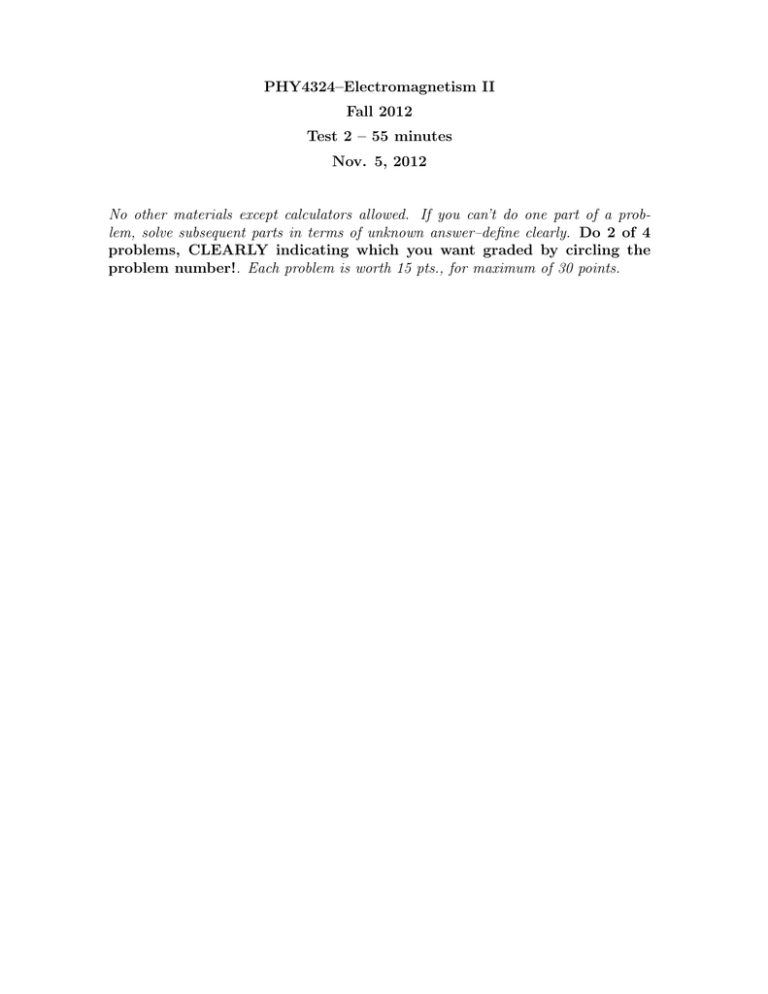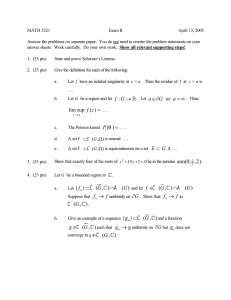PHY4324–Electromagnetism II Fall 2012 Test 2 – 55 minutes Nov. 5, 2012
advertisement

PHY4324–Electromagnetism II Fall 2012 Test 2 – 55 minutes Nov. 5, 2012 No other materials except calculators allowed. If you can’t do one part of a problem, solve subsequent parts in terms of unknown answer–define clearly. Do 2 of 4 problems, CLEARLY indicating which you want graded by circling the problem number!. Each problem is worth 15 pts., for maximum of 30 points. 1. (Orbiting charge) A particle with charge q moves in a circular orbit around the origin with radius R in the xy-plane with angular speed ω. At t = 0 the particle sits at the point (R, 0). (a) (4 pts.) Determine the Liénard-Wiechert potentials on the z-axis. (b) (4 pts.) Determine the charge’s acceleration vector a(r, t) in this frame. (c) (4 pts.) Find the electric and magnetic fields at the origin (careful!). (d) (3 pts.) The orbiting charge is now spread over a plastic ring rotating with angular velocity ω such that the linear charge density λ(θ) = λ0 sin(θ/2). Find the scalar potential V (r = 0, t) at the center of the ring. 2. (Waveguide) Consider TM modes (Bz =0) in the rectangular waveguide shown below. Begin with the equation for Ez , [ ] ∂2 ∂2 ω2 + + − k 2 Ez = 0. 2 2 2 ∂x ∂y c (a) (4 pts.) What is the boundary condition for E∥ at the surface? How does this translate into the boundary condition for Ez ? (b) (4 pts.) Using separation of variables, solve the differential equation for Ez , using the boundary condition from part (a). Be sure to include the dispersion relation (relation between k and ω) in your answer. (c) (4 pts.) What is the cutoff frequency? How does it compare to that for a TE mode? (d) (3 pts.) What are the group and phase velocities, respectively, for this waveguide (compare explicitly to c)? 3. (Transmission through thin film) A plane EM wave traveling from left to right is incident on a thin dielectric slab of width d as shown. In this problem, we will set up the equations for determining the transmission and reflection coefficients for normal incidence. Regions I and III are air and have index of refraction n = 1. In region II (glass), the index of refraction is n2 ≡ n. In all regions, µ = µ0 . (a) (4 pts.) Write expressions for the electric fields (only) in regions I,II, and III, taking into account the transmission and reflections at z = 0 and z = d. Be sure to define all symbols (e.g. the wave vectors in each region, and how they are related). (b) (4 pts.) What are the general boundary conditions for any EM wave (electric and magnetic field) that is normallly incident on an interface? (c) (4 pts.) For the electric fields (only) in regions I, II, and III from part (a), write down the specific boundary conditions at z = 0 and z = d, in terms of the part (a) fields. (d) (3 pts.) Define the reflection and transmission coefficients R and T in their most fundamental sense in terms of the electric fields. Explain in words how you would solve for them, and how the magnetic fields would enter the solution(you do not need to find them explicitly to get full credit here). 4. (Gauge transformations) (a) (5 pts.) Find the E and B fields and the charge and current distributions corresponding to V = 0 and bt ŝ, (1) 2πϵ0 s where b is a constant and s is the radial variable in cylindrical coordinates. Describe the physical situation and the meaning of b. A=− (b) (5 pts.) Find a gauge transformation λ(r, t) to new potentials V ′ = V − ∂λ/∂t and A′ = A + ∇λ such that A′ = 0. (That is, what are λ(r, t) and V ′ ) Do the new potentials satisfy the Coulomb gauge? Do they satisfy the Lorentz gauge? (c) (5 pts.) Is it always possible to find a gauge where A′ = 0 ? Is it always possible to find a gauge where V ′ = 0? Why or why not?






